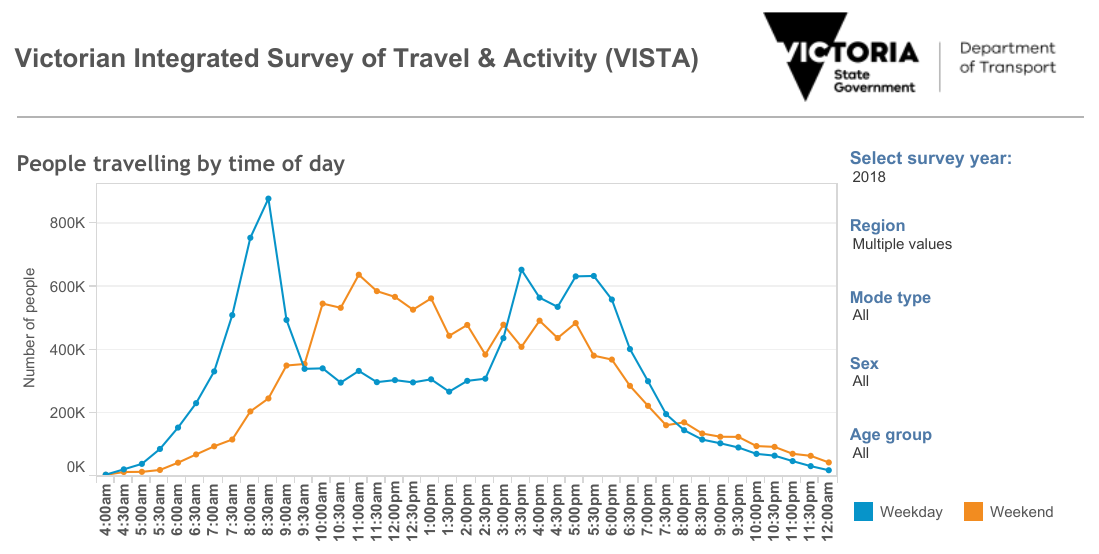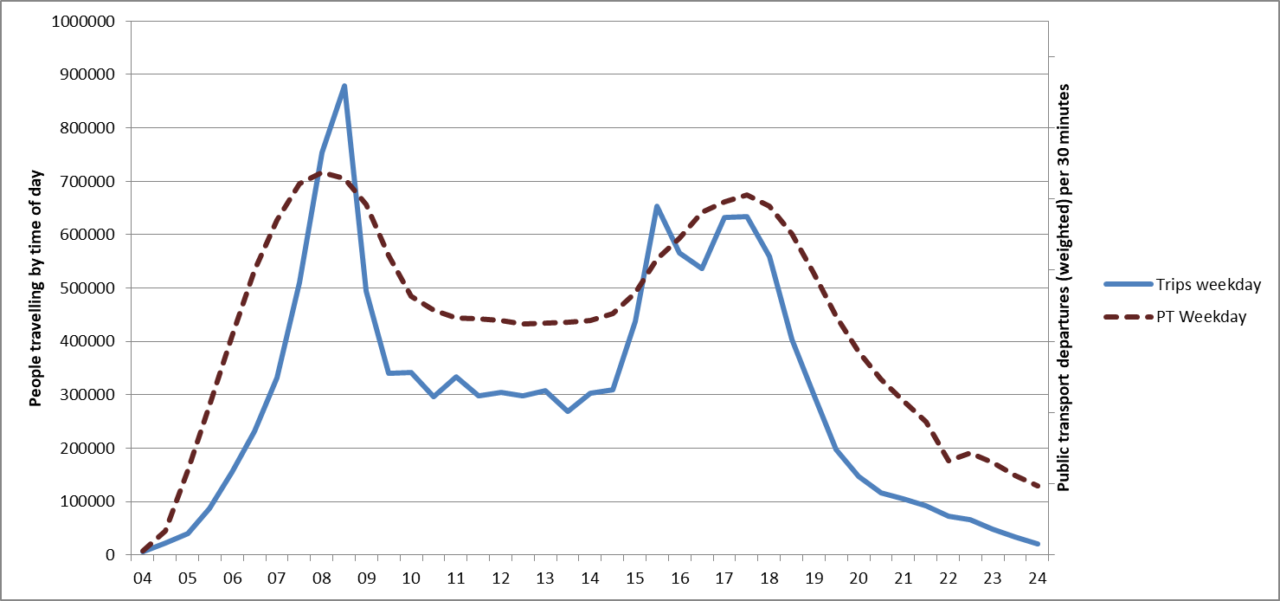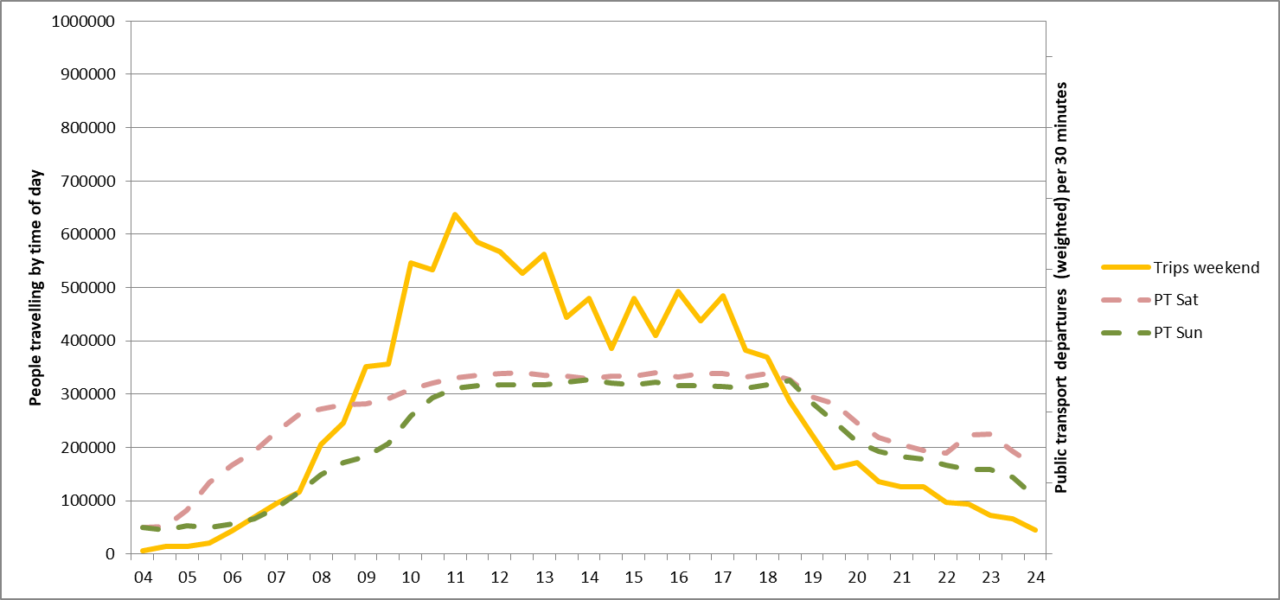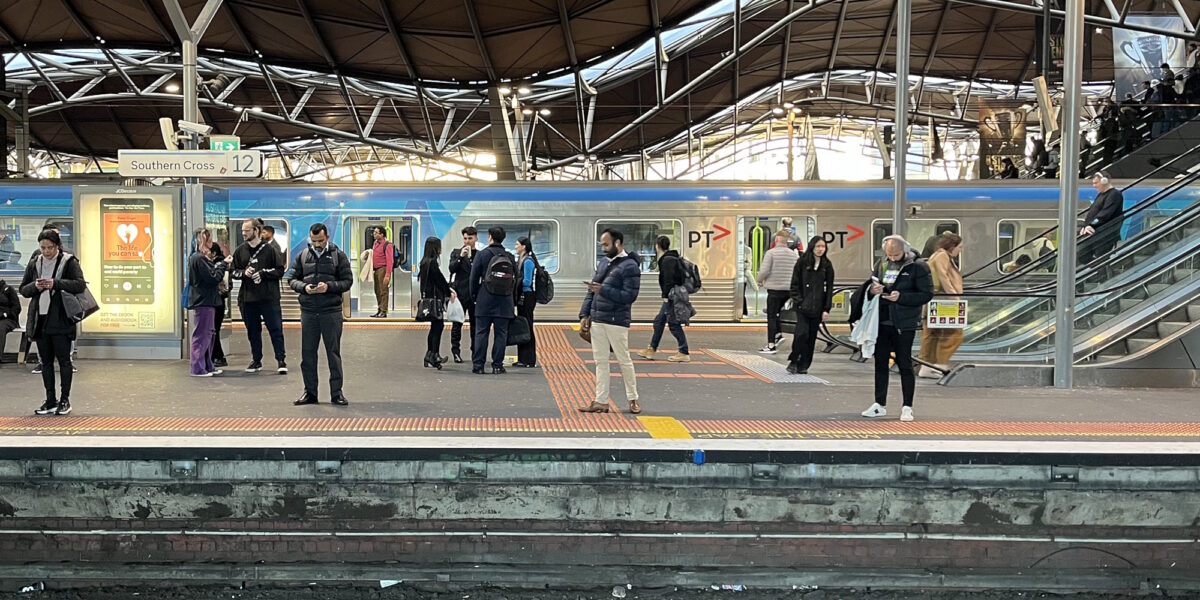Welcome news from the State Government this week with changes to buses around Deakin Burwood – a combination of mostly minor route changes and some extra services.
The press release also mentions extra route 903 services on Saturdays – they haven’t fixed the weird 15/15/30 frequencies on that part of the route – they’ve extended them to start earlier!
Fisherman’s Bend is also getting more services, partly thanks to a sensible decision not to run empty buses in heavy traffic all the way to Victoria Market.
Progress like this is welcome, particularly for buses.
A key challenge in Melbourne is for public transport services to better match travel demand.
Recently I found this fascinating graph is from the Victorian Integrated Survey of Travel and Activity (VISTA for short), showing how many people are travelling around Melbourne across the day, weekday and weekend.

In the selection, I’ve excluded Geelong, so this is greater Melbourne we’re looking at. I’ve also used 2018 rather than 2020 (which was obviously affected by COVID lockdowns). 2023 no doubt is different, but is probably closer to 2018 than 2020.
Morning peak travel is as one might expect. A high peak, as large numbers of workers and students head to their destinations.
The evening peak is less peaky, because many students head home earlier than 9-5 workers.
What really surprises me is that weekend travel, particularly between 10am and 1pm, is similar in volume to weekday afternoon peak.
The data says on weekends there’s a peak at 11am of 637,501 people are travelling; the peak on weekday afternoon is 653,196, a difference of just 2.4%.
Given since COVID, peak hour travel (particularly into the CBD) has reduced, but off-peak travel is as strong as ever, there’s a good chance weekend lunchtime travel now exceeds weekday afternoon peaks.
Travel demand vs PT provision
The problem is that overall travel demand is completely at odds with public transport provision in Melbourne.
During morning and evening peak, most of Melbourne’s trains and trams and a few bus routes provide an intensive frequent service. Providing this frequent service drives much of the investment in infrastructure and fleet.
Weekends in many cases get a bare bones service, particularly buses.
To try and compare, I got the GTFS data, and wrestled with it for ages to try and work out systemwide departures by hour and day. It was very complicated, and I can’t guarantee it’s exactly right, but I think it’s close enough to try and measure it against travel demand.
I took networkwide departures per half-hour, weighted them against mode (to estimate capacity), and scaled the numbers on the charts so weekday afternoon peak travel demand is shown as comparable to PT provision.
This is not to say that PT provision is adequate in afternoon peak, but just to use this as a baseline to compare with other times of the week.
Remembering that this data is pre-COVID, here’s weekdays:

Some observations:
Morning peak travel demand is traditionally more intense than afternoon (probably due to students travelling at the same time as office workers heading to an 8-9am start). But many PT routes have about the same frequency in morning and afternoon peak, and are consequently can get stretched in the mornings.
At other times on weekdays (inter-peak and evenings), PT broadly scales up and down more-or-less in proportion with demand.
There’s a huge caveat, where this type of comparison falls down. This is only really a measure of capacity. If you reduce service at quieter times, cutting capacity also usually cuts frequency – so it can lead to an infrequent network that most people won’t want to use. (See: most of Melbourne’s buses)
Now let’s compare travel demand vs PT on weekends, with the same vertical scale as weekdays:

What’s really noticeable is that using weekday peak as the baseline, weekend PT service is nowhere near proportionate to weekend travel demand.
With so many people travelling, the service should be much better than it is.
This varies widely by route. Some services, particularly trams and trains, run similar frequencies on weekends as they do on weekdays off-peak.
But many buses run much less frequently on weekends. Prime examples are most Smartbuses, and many local buses – the service is often half as frequent on weekends. (Some newer bus routes run a flatter timetable, which is good – except that the frequencies are still usually poor.)
Adapting to modern travel demand
In decades gone past, the public transport network provided for a peak around lunchtime on Saturday, because until 1948 it was common for many workers to work Monday to Friday plus 4 hours on Saturday mornings.
This photo recently posted by the PTUA shows a lunchtime crowd at Flinders Street Station. The clocks show 1:25pm – I suspect it was a Saturday afternoon.
Even bearing in mind the limitations of the comparisons I’ve presented above, it’s clear that nowadays, public transport services are out of step with travel demand. There are long waits and even crowding now commonplace outside peak.
Melbourne’s PT network hasn’t adapted to changing travel patterns, resulting in a failure to capture market share, particularly on weekends.
Another graph back on the VISTA page shows slightly different numbers – Trips In Progress – but also with mode share (active, public, private transport).
I mean to crunch those numbers another time, but unsurprisingly, PT does best in weekday peaks, when the services are best and the traffic is worst.

PT does far worse on weekends, despite traffic often being bad (eg plenty of travel demand), because PT services are less frequent.
The few services running decent frequencies on weekends generally get plenty of patronage, sometimes to the point of being overcrowded.
Poor frequencies are common right across Melbourne, particularly on bus routes, including for routes serving very busy destinations like shopping centres.
The data shows weekend travel demand is comparable to weekday peak. To meet that demand, public transport service provision should also be comparable.
You wouldn’t run any other kind of business like this, ignoring clear demand from customers. No wonder cars dominate for weekend travel.

12 replies on “Weekend PT not matching travel demand”
I hope with the data backing this, peak frequency can be spread out more into the off-peak and intra-peak time, and have some weekend more weekend services extended to 10 minute frequency to match some of the lines that already get this. We already have the capacity for it, the transport companies will probably need to hire additional staff to cover the roster though.
And it goes without saying it’s not just the trains, but the buses too as commuters need that connection at stations. When there are sports events on weekends, the car park can sometimes be half as full as as on weekdays.
A very thorough analysis. Anyone catching PT on the weekend already knows it can get quite busy, no surprise that’s backed up by the data. The system desperately needs to get out of the 1950s-era mindset that seems to inform service scheduling – the lack of early PT options on Sundays is a classic example of this.
On weekends, many people have to drive because of poor public transport, so increasing services is one way to get people out of their cars and onto public transport. However, that is not the only way it can be done, as promoting public transport through the media is another way it can be done, and both can be done in tandem with each other.
And with Night Bus, many 24-hour routes (including 420 here in Delahey) seems to move to hourly at 2100 on Friday and Saturday nights, while trains are still at 20 or 30 minute frequency, and it can get worse when there is a sporting event or concert (or even New Years’ Eve celebrations) in which there would be many people using public transport, and buses would be critical to moving people around. So when it comes to these events, increasing the frequency of buses (as well as other modes of transport) would be a great way to promote public transport, and it can be done by increasing the frequency of trains and trams, as well as doubling the frequency of Night Bus to at least half-hourly, especially on New Years’ Eve (it works for trains and trams on NYE, so we should double the frequency of buses on the night as well).
In addition, some services don’t run on weekends (I am looking at Route 800), so start running services on 800 on weekends to get people out of cars and onto buses, especially as weekends tend to be busy at shopping centres as people often go grocery shopping on weekends.
“You wouldn’t run any other kind of business like this, ignoring clear demand from customers.”
* Australia Post enters the chat.
Yes, in an era where 24/7 internet shopping has been a thing for a quarter of a century (eBay turns 30 in 2025!), post offices are still open 9-5 Monday to Friday, with an optional half-day Saturday, and closed on Sundays and public holidays – all up, post offices are closed for roughly a quarter of the year (52 Sundays, 26 Saturdays (52 half-days), and let’s say 15 public holidays).
Even though most post offices are open on Saturday mornings and the trucks are ferrying mail between sorting centres 24/7, letter and parcel deliveries still only occur Monday to Friday between 9AM and 5PM, just like a bottom-tier bus route (the 740 is a perfect example).
Also banks and government buildings such as Centrelink/DHHS/council offices, which tend to have even worse hours than post offices.
Something to consider about weekend PT use is the vast difference in travel patterns as compared to weekdays.
PT in Melbourne is largely set up to bring masses of people from the burbs to the city. While there’s still plenty going on in the city on weekends, PT simply can’t get you from a 10am junior cricket game on a different ground each week, to lunch at a friend’s, to a 3pm junior basketball game at a rotating roster of stadia, to the supermarket, and home again. Increased frequencies and promotions can’t counter the extra randomness and complexity of weekend travel, particularly for families.
@Jim, that’s a good point – some complex journeys are clearly more likely to be by car. But PT (especially on weekends) is completely failing even journeys that do suit it – such as those to big shopping centres. That’s a market it could compete in, but doesn’t.
[…] We know journeys to the CBD are still well down, especially in peak, and especially on Mondays and Fridays, due to ongoing widespread Work From Home for office workers. There’s some more data that I’ll explore in a future post, but it’s a reminder that government should be planning and funding the public transport network to more actively chase patronage for non-CBD, non-peak trips. […]
[…] These days, fewer people are going into CBD offices five days a week, but people are still travelling, particularly on weekends and evenings… to the extent that roads are often congested and PT is often crowded at these times due to lack of services. […]
[…] it was imagined not to be a problem at other times. The reality is weekend travel demand is often just as strong as peak, and the Wurundjeri Way exit feeds directly to Marvel Stadium in Docklands, with the worst […]
[…] transport has been lagging on weekend service provision for years. Infrequent services continue to discourage people from using the […]
[…] Since Labor came into power in 2014, Werribee has had some train and bus service upgrades, but they’re still left with trains only every 20 minutes outside peak hour, and many local bus services are infrequent. Peak buses are about every 20 minutes at best, and on weekends wait times are often 2-3 times that, despite overall travel demand being similar to weekday afternoon peak. […]
[…] Lack of weekend service isn’t just a Melbourne CBD problem; it’s also an issue across the rest of the urban area. […]